Zusammenfassung
Graphitic carbon nitride (g-CN) films are important components of optoelectronic devices, but current techniques for their production, such as drop casting and spin coating, fail to deliver uniform and pinhole-free g-CN films on solid substrates. Here, versatile, cost-effective, and large-area growth of uniform and pinhole-free g-CN films is achieved by using a thermal vapor condensation method ...
Zusammenfassung
Graphitic carbon nitride (g-CN) films are important components of optoelectronic devices, but current techniques for their production, such as drop casting and spin coating, fail to deliver uniform and pinhole-free g-CN films on solid substrates. Here, versatile, cost-effective, and large-area growth of uniform and pinhole-free g-CN films is achieved by using a thermal vapor condensation method under atmospheric pressure. A comparison of the X-ray diffraction and Fourier transform infrared data with the calculated infrared spectrum confirmed the graphitic build-up of films composed of tri-s-triazine units. These g-CN films possess multiple active energy states including π*, π, and lone-pair states, which facilitate their efficient (6 % quantum yield in the solid state) photoluminescence, as confirmed by both experimental measurements and theoretical calculations.




 Altmetric
Altmetric